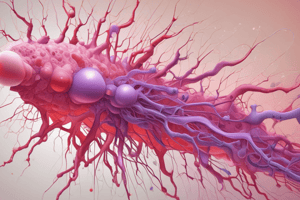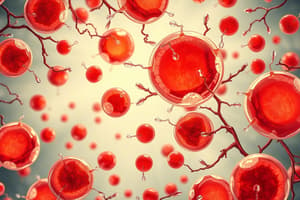Podcast
Questions and Answers
What percentage of total body weight does blood represent?
What percentage of total body weight does blood represent?
- 12%
- 5%
- 10%
- 8% (correct)
What is the average packed cell volume (PCV) for women?
What is the average packed cell volume (PCV) for women?
- 38%
- 42% (correct)
- 45%
- 50%
Which cellular element is primarily responsible for immunity?
Which cellular element is primarily responsible for immunity?
- Leukocytes (correct)
- Plasma
- Erythrocytes
- Thrombocytes
What is the average total blood volume in men?
What is the average total blood volume in men?
What constitutes 90% of plasma?
What constitutes 90% of plasma?
What is the primary function of albumin in plasma?
What is the primary function of albumin in plasma?
Which of the following is NOT a function of plasma electrolytes?
Which of the following is NOT a function of plasma electrolytes?
What is the average concentration of globulins in plasma?
What is the average concentration of globulins in plasma?
Which plasma protein is synthesized in the reticuloendothelial system by plasma cells?
Which plasma protein is synthesized in the reticuloendothelial system by plasma cells?
What condition can result from a decrease in albumin levels?
What condition can result from a decrease in albumin levels?
Flashcards
Plasma
Plasma
The liquid portion of blood, making up about 55-58% of total blood volume.
Hematocrit
Hematocrit
The percentage of red blood cells in the total blood volume.
Hemostasis
Hemostasis
The process of stopping bleeding, usually by forming a clot.
Erythrocytes
Erythrocytes
Signup and view all the flashcards
Leukocytes
Leukocytes
Signup and view all the flashcards
What are electrolytes?
What are electrolytes?
Signup and view all the flashcards
What is Albumin?
What is Albumin?
Signup and view all the flashcards
What are Globulins?
What are Globulins?
Signup and view all the flashcards
What is Fibrinogen?
What is Fibrinogen?
Signup and view all the flashcards
What is Hypoalbuminemia?
What is Hypoalbuminemia?
Signup and view all the flashcards
Study Notes
Hematology and Immune System
- This lecture covers the hematology and immune system
- The presenter, Dr. Nisreen Daffa Alla, has qualifications in M.B.B.S., PhD (Human Physiology), and MSc health Profession Education.
- References used include "Human Physiology" by Lauralee Sherwood (7th edition), "Textbook of Physiology" by Guyton & Hall (11th edition), "Textbook of Physiology" by Linda S. Contanzo (3rd edition), and "Physiology" by Berne and Levy (6th edition).
Plasma Proteins
- Plasma proteins make up 6% to 8% of plasma's total weight.
- There are 3 main groups of plasma proteins:
- Albumins (most abundant):
- 60% of plasma proteins
- Major component of plasma osmotic pressure (80-90%)
- Synthesized in the liver, with a half-life of 20 days (10-12g/day production)
- Buffer pH
- Decreased albumin (hypoalbuminaemia) leads to fluid leakage from the circulation, causing edema.
- Causes include malnutrition, liver disease, and kidney disease.
- Globulins (3 subclasses):
- Synthesized in the liver or reticuloendothelial system
- Alpha globulins transport water-insoluble substances (lipoproteins, lipids, hormones).
- Beta globulins transport lipids, cholesterol, iron, and copper.
- Gamma globulins (immunoglobulins) function as antibodies.
- Fibrinogen:
- Synthesized in the liver
- Crucial for blood clot formation
- Deficiency can cause excessive bleeding.
- Albumins (most abundant):
Plasma Protein Concentrations (Average)
- Albumin: 4.8 g/100ml
- Globulins: 2.3 g/100ml
- Fibrinogen: 0.3 g/100ml
- Total: 7.4 g/100ml
Plasma Protein Functions
| Plasma Protein | Function |
|---|---|
| Lipoprotein | Nutrients |
| Alkaline Phosphatase, Amylase | Enzymes |
| Angiotensin | Hormone |
| γ-Globulin | Antibodies |
| Fibrinogen | Clotting factor |
| Albumin, Ceruloplasmin, Transferrin | Carriers |
| Gasoline, Gc protein | Scavengers |
Plasma Electrolytes
- Major plasma electrolytes include Na+, K+, Cl–, and HCO3–.
- Functions:
- Maintain membrane potentials
- Control osmotic distribution of fluids between ECF and ICF
- Buffer pH changes
Blood Composition
- Blood accounts for approximately 8% of total body weight.
- Average volume:
- 5 liters in women
- 5.5 liters in men
- Composed of two parts: plasma (liquid) and cellular elements.
Cellular Elements
- Erythrocytes (red blood cells): most numerous; transport O2, CO2, and buffer hydrogen ions.
- Leukocytes (white blood cells): crucial for immunity.
- Thrombocytes (platelets): vital for hemostasis (blood clotting).
Hematocrit/Packed Cell Volume (PCV)
- Hematocrit (PCV) represents the percentage of erythrocytes in the total blood volume.
- Average PCV is 45% in men and 42% in women
Blood Centrifugation
- Separates blood into plasma (55%), buffy coat (<1%) and RBCs (45%)
Blood Functions
- Transport: respiratory gases (O2 & CO2), nutrients, metabolites, hormones, drugs, and enzymes.
- Defense against infections.
- Regulation of homeostasis: body temperature, acid-base balance, and fluid and electrolyte balance.
Objectives of the Lecture
- Describe blood composition
- List plasma proteins
- Explain plasma protein functions
- Relate plasma protein changes to clinical conditions
Case Study (Patient)
- 55-year-old male with new-onset ascites and lower extremity edema
- Moderate alcohol consumption; jaundice
- Mild abdominal tenderness; no organomegaly
- Lower-extremity edema to mid-calf
- Pedal pulses barely palpable
- Investigations include abnormal BUN, creatinine, AST, ALT, serum albumin, platelets, sodium, potassium, alkaline phosphatase, and total bilirubin levels.
The Patient's Diagnosis and Questions
- Diagnosed with liver failure
- Questions posed regarding the cause and development of edema in the patient.
Case Study - Fibrinogen Deficiency
- Congenital absence of fibrinogen (fibrinogenemia) will present with excessive bleeding.
Revision Questions
- Mention blood components
- Identify the most numerous blood cell
- List three plasma proteins and their functions
- Detail the site of synthesis and function of albumin, alpha and beta globulin, and gamma globulin .
Studying That Suits You
Use AI to generate personalized quizzes and flashcards to suit your learning preferences.




